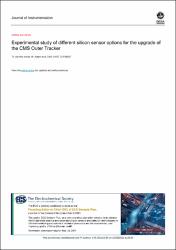Experimental study of different silicon sensor options for the upgrade of the CMS Outer Tracker

View/
Access
info:eu-repo/semantics/openAccessDate
2020Author
Sirunyan, A. M.Tumasyan, A.
Adam, W.
Ambrogi, F.
Asilar, E.
Bergauer, T.
Özdemir, Kadri
CMS Collaboration
Metadata
Show full item recordAbstract
During the high-luminosity phase of the LHC (HL-LHC), planned to start in 2027, the accelerator is expected to deliver an instantaneous peak luminosity of up to 7.5 x 10(34) cm(-2) s(-1). A total integrated luminosity of 3000 or even 4000 fb(-1) is foreseen to be delivered to the general purpose detectors ATLAS and CMS over a decade, thereby increasing the discovery potential of the LHC experiments significantly. The CMS detector will undergo a major upgrade for the HL-LHC, with entirely new tracking detectors consisting of an Outer Tracker and Inner Tracker. However, the new tracking system will be exposed to a significantly higher radiation than the current tracker, requiring new radiation-hard sensors. CMS initiated an extensive irradiation and measurement campaign starting in 2009 to systematically compare the properties of different silicon materials and design choices for the Outer Tracker sensors. Several test structures and sensors were designed and implemented on 18 different combinations of wafer materials, thicknesses, and production technologies. The devices were electrically characterized before and after irradiation with neutrons, and with protons of different energies, with fluences corresponding to those expected at different radii of the CMS Outer Tracker after 3000 fb(-1). The tests performed include studies with beta sources, lasers, and beam scans. This paper compares the performance of different options for the HL-LHC silicon sensors with a focus on silicon bulk material and thickness.
Volume
15Issue
4Collections
Related items
Showing items related by title, author, creator and subject.
-
Mechanical stability of the CMS strip tracker measured with a laser alignment system
Sirunyan, A. M.; Tumasyan, A.; Adam, W.; Asilar, E.; Bergauer, T.; Brandstetter, J.; Özdemir, Kadri; CMS Collaboration (Iop Publishing Ltd, 2017)The CMS tracker consists of 206m(2) of silicon strip sensors assembled on carbon fibre composite structures and is designed for operation in the temperature range from -25 to + 25 degrees C. The mechanical stability of ... -
Precision measurement of the structure of the CMS inner tracking system using nuclear interactions
Sirunyan, A. M.; Tumasyan, A.; Adam, W.; Ambrogi, F.; Asilar, E.; Bergauer, T.; Özdemir, Kadri; CMS Collaboration (Iop Publishing Ltd, 2018)The structure of the CMS inner tracking system has been studied using nuclear interactions of hadrons striking its material. Data from proton-proton collisions at a center-of-mass energy of 13 TeV recorded in 2015 at the ... -
Jet energy scale and resolution in the CMS experiment in pp collisions at 8 TeV
Khachatryan, V.; Sirunyan, A. M.; Tumasyan, A.; Adam, W.; Asilar, E.; Bergauer, T.; Özdemir, Kadri; CMS Collaboration (Iop Publishing Ltd, 2017)Improved jet energy scale corrections, based on a data sample corresponding to an integrated luminosity of 19.7 fb(-1) collected by the CMS experiment in proton-proton collisions at a center-of-mass energy of 8 TeV, are ...
















